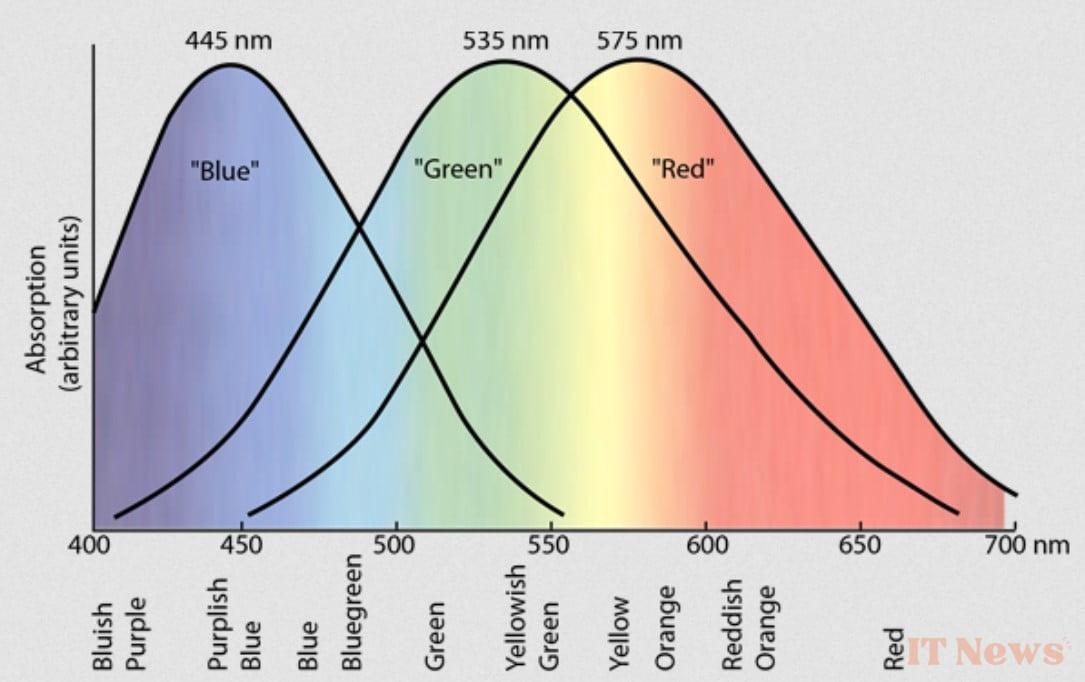A team of American researchers recently made headlines with a rather intriguing claim: in their latest study, they explain having discovered... a new color, never before seen by humans.
What we commonly call color is a complex visual perception, resulting from the way our brain interprets the signals produced by the retina. The role of the retina is to produce a signal when stimulated by light in a very specific wavelength range, between approximately 380 nm and 750 nm. We talk about the visible spectrum, and it is often represented using a rainbow that includes all the colors associated with this range of wavelengths.
This function relies on specialized cells, photoreceptors called cones. There are three types, each reacting to a different portion of this visible spectrum. S cones, for example, are more sensitive to shorter wavelengths and are generally associated with the perception of blue. The M cones, on the other hand, are sensitive to intermediate wavelengths, which correspond to green, while the L cones react to longer wavelengths, which correspond to the color red.
Visible, but impossible colors
The combination of signals from these cones, sensitive to different portions of the light spectrum, is then processed by the brain to create the wide range of colors we know. However, it is important to note that the different color ranges associated with each type of receptor are not entirely separate. As seen in the graph below, these wavelength ranges overlap.
This means that a given light signal cannot in any case stimulate only one type of cone without affecting the others; Whatever wavelength is chosen, it will inevitably provoke a more or less strong reaction from at least two types of photoreceptors.
This precision might seem anecdotal, but it has a very important implication. It means that there are purely theoretical colors, which the human eye will never be able to observe under normal conditions. To achieve this, it would be necessary to stimulate only one type of cone while keeping the others at rest, which cannot happen naturally for all the reasons mentioned above.
Olo, a “new color”
This is where the researchers from the Universities of Berkeley and Washington, who are behind this study, come in. Together, they designed an optical device called Oz, in reference to the famous book by Lyman Frank Baum. Its role is to “hack” the retina by individually activating certain photoreceptors using a laser. In theory, this targeted stimulation, completely impossible under natural viewing conditions, should therefore be interpreted by the brain as a new, unknown color, absent from the famous rainbow.
To test this hypothesis, the researchers became guinea pigs. They sat in front of a neutral gray background while the prototype’s laser was tasked with stimulating only the M cones, the most sensitive to wavelengths associated with green. And the experiment seems to have been a great success: all participants claim to have observed a “new” color, which was later called Olo. For obvious reasons, it is unfortunately impossible to allow you to visualize it. But the authors describe it as an exceptionally intense and saturated version of the pastel green shown below.
The authors then took the experiment even further. They asked participants to follow a moving white dot while they aimed the Oz laser at small regions of the retina. The guinea pigs report observing “different colors of the rainbow,” as well as a host of other “unprecedented colors beyond the natural human range.”
According to the researchers, this is “indisputable proof” of the existence of a new color. But some of their colleagues are more cautious. John Barbur, an optics researcher at the University of London, for example, told the BBC that this claim was "open to debate." He readily admits that the ability to stimulate retinal photoreceptors with such precision represents a "technological feat." However, he remains more cautious about the researchers' claims. According to him, this unnatural stimulation of the retina could influence the perception of parameters such as brightness or hue, and therefore produce a more intense version of an already known color, instead of a new color per se.
Potential for research and medicine
But regardless, this work remains quite fascinating. Ultimately, the researchers' prototype still embodies a new way of probing the human visual system to understand how it works and explore its limits. Once mature, it could even become the focus of new therapeutic approaches, for example, to correct the retina of colorblind people.
“Oz represents a new category of experimental platform for vision science and neuroscience, which aims to fully control the first neuronal layer of the brain and program the activation of each photoreceptor at any time,” the researchers summarize. “Our prototype represents a step forward in this type of neural control, and we demonstrate its ability to precisely deliver microdoses of light to target cones.””
The text of the study is available here.





0 Comments